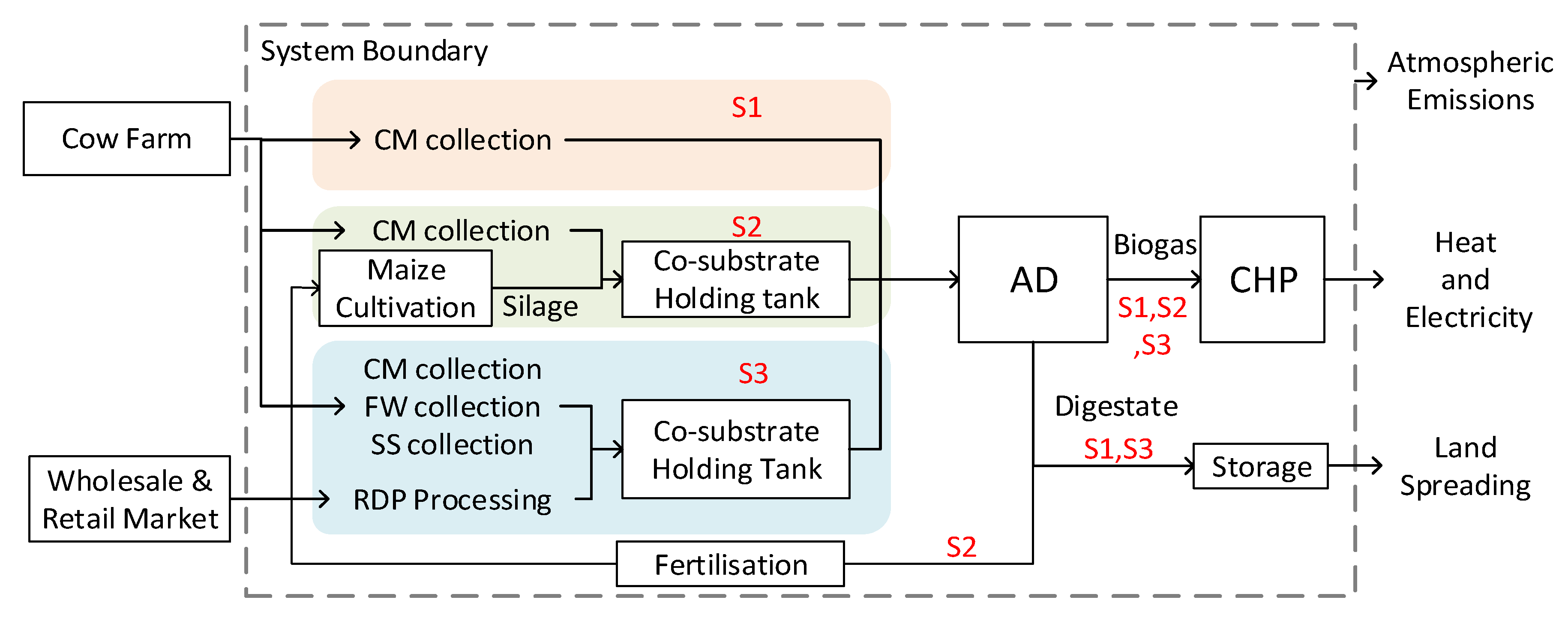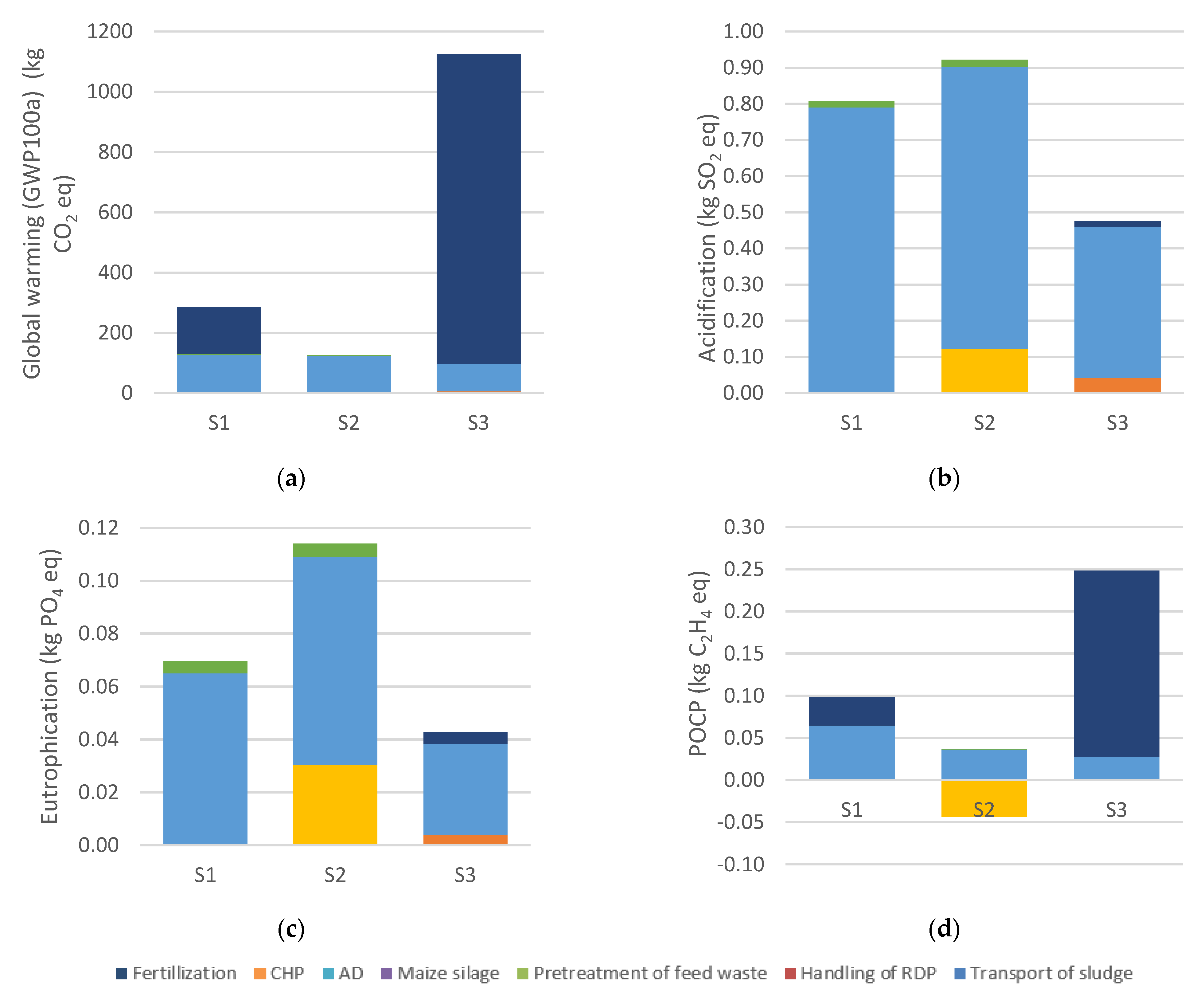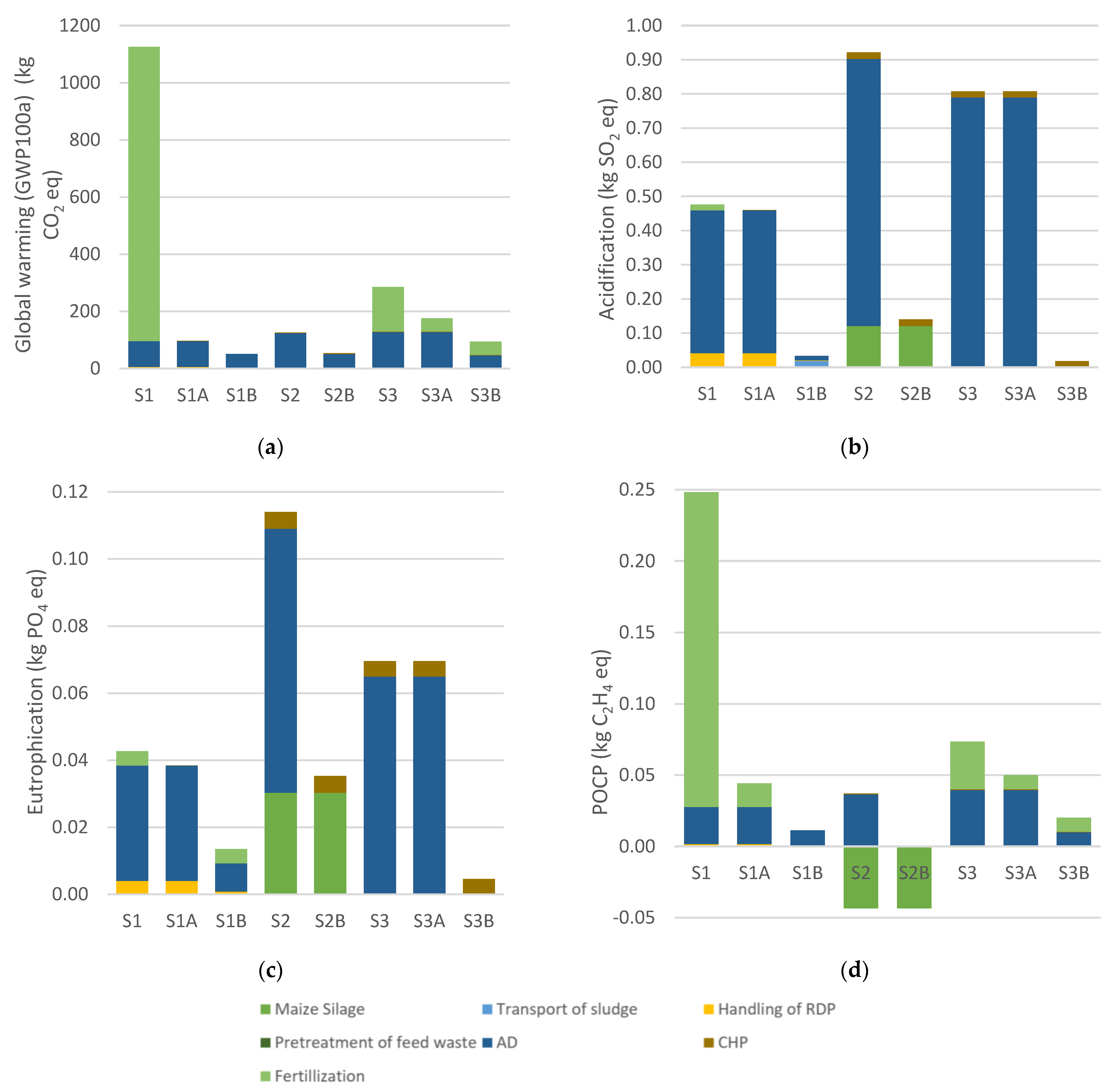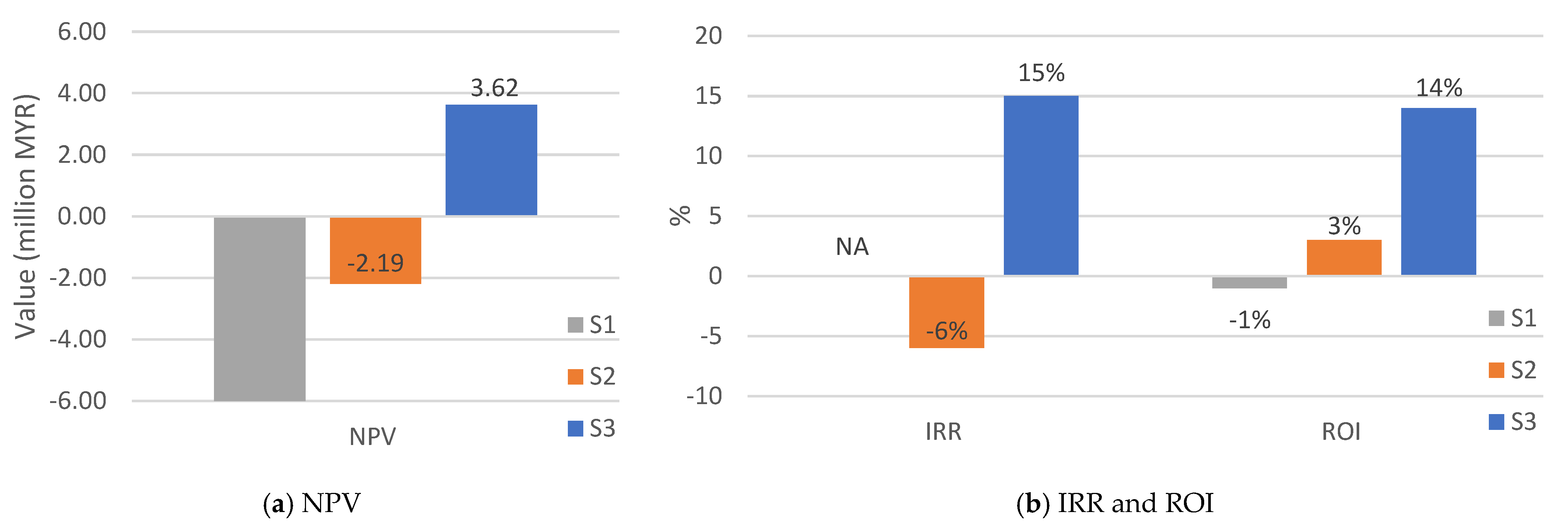Life Cycle Assessment and Techno-Economic Analysis for Anaerobic Digestion as Cow Manure Management System
Abstract
1. Introduction
2. Methodology
2.1. Life Cycle Assessment
2.1.1. Goal and Scope Definition
- Scenario 1 (S1): mono-digestion of CM;
- Scenario 2 (S2): co-digestion of CM with maize silage;
- Scenario 3 (S3): co-digestion of CM, SS, RDP and FW.
2.1.2. Life Cycle Inventory (LCI)
2.1.3. Life Cycle Inventory Assessment (LCIA)
2.1.4. Life Cycle Interpretation
- S1A: mono-digestion of CM, closed storage system, grid-powered energy supply
- S1B: mono-digestion of CM, closed storage system, PV energy supply
- S2B: co-digestion of CM and maize silage, PV energy supply
- S3A: co-digestion of CM, RDP, SS and FW, closed storage system, grid-powered energy supply
- S3B: co-digestion of CM, RDP, SS and FW, closed storage system, PV energy supply
2.2. Techno-Economic Analysis (TEA)
3. Result and Discussion
3.1. Environmental Performance
3.1.1. Global Warming Potential (GWP100a)
3.1.2. Acidification Potential and Eutrophication Potential
3.1.3. Photochemical Ozone Creation Potential
3.2. Effect of Digestate Management and Fossil Energy Alternative on LCA Result
3.3. Techno-Economic Analysis (TEA)
3.3.1. CAPEX and OPEX
3.3.2. NPV, IRR, ROI and SPP
4. Conclusions
Supplementary Materials
Author Contributions
Funding
Data Availability Statement
Conflicts of Interest
References
- Sandars, D.L.; Audsley, E.; Cañete, C.; Cumby, T.R.; Scotford, I.M.; Williams, A.G. Environmental Benefits of Livestock Manure Management Practices and Technology by Life Cycle Assessment. Biosyst. Eng. 2003, 84, 267–281. [Google Scholar] [CrossRef]
- Berendes, D.M.; Yang, P.J.; Lai, A.; Hu, D.; Brown, J. Estimation of global recoverable human and animal faecal biomass. Nat. Sustain. 2018, 1, 679–685. [Google Scholar] [CrossRef]
- Feng, L.; Ward, A.J.; Moset, V.; Møller, H.B. Methane emission during on-site pre-storage of animal manure prior to anaerobic digestion at biogas plant: Effect of storage temperature and addition of food waste. J. Environ. Manag. 2018, 225, 272–279. [Google Scholar] [CrossRef] [PubMed]
- Nasir, I.; Mohd Ghazi, T. Pretreatment of lignocellulosic biomass from animal manure as a means of enhancing biogas production. Eng. Life Sci. 2015, 15, 733–742. [Google Scholar] [CrossRef]
- Nazari, L.; Sarathy, S.; Santoro, D.; Ho, D.; Ray, M.B.; Xu, C. Recent advances in energy recovery from wastewater sludge. In Direct Thermochemical Liquefaction for Energy Applications; Rosendahl, L., Ed.; Woodhead Publishing: Sutton, UK, 2018; pp. 67–100. [Google Scholar]
- Oehmichen, K.; Thrän, D. Fostering renewable energy provision from manure in Germany–where to implement GHG emission reduction incentives. Energy Policy 2017, 110, 471–477. [Google Scholar] [CrossRef]
- Breitenmoser, L.; Gross, T.; Huesch, R.; Rau, J.; Dhar, H.; Kumar, S.; Hugi, C.; Wintgens, T. Anaerobic digestion of biowastes in India: Opportunities, challenges and research needs. J. Environ. Manag. 2019, 236, 396–412. [Google Scholar] [CrossRef] [PubMed]
- Jiang, X.; Sommer, S.G.; Christensen, K.V. A review of the biogas industry in China. Energy Policy 2011, 39, 6073–6081. [Google Scholar] [CrossRef]
- Mezzullo, W.G.; McManus, M.C.; Hammond, G.P. Life cycle assessment of a small-scale anaerobic digestion plant from cattle waste. Appl. Energy 2013, 102, 657–664. [Google Scholar] [CrossRef]
- Hijazi, O.; Munro, S.; Zerhusen, B.; Effenberger, M. Review of life cycle assessment for biogas production in Europe. Renew. Sustain. Energy Rev. 2016, 54, 1291–1300. [Google Scholar] [CrossRef]
- Wang, Y.; Zhang, Y.; Li, J.; Lin, J.-G.; Zhang, N.; Cao, W. Biogas energy generated from livestock manure in China: Current situation and future trends. J. Environ. Manag. 2021, 297, 113324. [Google Scholar] [CrossRef]
- Singh, A.D.; Upadhyay, A.; Shrivastava, S.; Vivekanand, V. Life-cycle assessment of sewage sludge-based large-scale biogas plant. Bioresour. Technol. 2020, 309, 123373. [Google Scholar] [CrossRef] [PubMed]
- Ardolino, F.; Parrillo, F.; Arena, U. Biowaste-to-biomethane or biowaste-to-energy? An LCA study on anaerobic digestion of organic waste. J. Clean. Prod. 2018, 174, 462–476. [Google Scholar] [CrossRef]
- Foreest, F.V. Perspectives for Biogas in Europe; Oxford Institute for Energy Studies: Oxford, UK, 2012. [Google Scholar]
- Li, Y.; Zhao, J.; Krooneman, J.; Euverink, G.J.W. Strategies to boost anaerobic digestion performance of cow manure: Laboratory achievements and their full-scale application potential. Sci. Total Environ. 2021, 755, 142940. [Google Scholar] [CrossRef] [PubMed]
- Nasir, I.M.; Mohd Ghazi, T.I.; Omar, R. Anaerobic digestion technology in livestock manure treatment for biogas production: A review. Eng. Life Sci. 2012, 12, 258–269. [Google Scholar] [CrossRef]
- Meegoda, J.N.; Li, B.; Patel, K.; Wang, L.B. A Review of the Processes, Parameters, and Optimization of Anaerobic Digestion. Int. J. Environ. Res. Public Health 2018, 15, 2224. [Google Scholar] [CrossRef]
- Torrellas, M.; Burgos, L.; Tey, L.; Noguerol, J.; Riau, V.; Palatsi, J.; Antón, A.; Flotats, X.; Bonmatí, A. Different approaches to assess the environmental performance of a cow manure biogas plant. Atmos. Environ. 2018, 177, 203–213. [Google Scholar] [CrossRef]
- Shin, Y.-S.; Cho, K. BIM Application to Select Appropriate Design Alternative with Consideration of LCA and LCCA. Math. Probl. Eng. 2015, 2015, 281640. [Google Scholar] [CrossRef]
- Timonen, K.; Sinkko, T.; Luostarinen, S.; Tampio, E.; Joensuu, K. LCA of anaerobic digestion: Emission allocation for energy and digestate. J. Clean. Prod. 2019, 235, 1567–1579. [Google Scholar] [CrossRef]
- van den Oever, A.E.M.; Cardellini, G.; Sels, B.F.; Messagie, M. Life cycle environmental impacts of compressed biogas production through anaerobic digestion of manure and municipal organic waste. J. Clean. Prod. 2021, 306, 127156. [Google Scholar] [CrossRef]
- Collet, P.; Flottes, E.; Favre, A.; Raynal, L.; Pierre, H.; Capela, S.; Peregrina, C. Techno-economic and Life Cycle Assessment of methane production via biogas upgrading and power to gas technology. Appl. Energy 2017, 192, 282–295. [Google Scholar] [CrossRef]
- Imeni, S.M.; Puy, N.; Ovejero, J.; Busquets, A.M.; Bartroli, J.; Pelaz, L.; Ponsá, S.; Colón, J. Techno-Economic Assessment of Anaerobic Co-digestion of Cattle Manure and Wheat Straw (Raw and Pre-treated) at Small to Medium Dairy Cattle Farms. Waste Biomass Valorization 2020, 11, 4035–4051. [Google Scholar] [CrossRef]
- Tan, J.B.; Jamali, N.S.; Tan, W.E.; Che Man, H.; Zainal Abidin, Z. Techno-Economic Assessment of On-Farm Anaerobic Digestion System Using Attached-Biofilm Reactor in the Dairy Industry. Sustainability 2021, 13, 2063. [Google Scholar] [CrossRef]
- Aui, A.; Li, W.; Wright, M.M. Techno-economic and life cycle analysis of a farm-scale anaerobic digestion plant in Iowa. Waste Manag. 2019, 89, 154–164. [Google Scholar] [CrossRef] [PubMed]
- Rajendran, K.; Murthy, G.S. Techno-economic and life cycle assessments of anaerobic digestion—A review. Biocatal. Agric. Biotechnol. 2019, 20, 101207. [Google Scholar] [CrossRef]
- Tan, W.E.; Liew, P.Y.; Bong, C.P.C.; Van Fan, Y.; Tan, L.S.; Jamian, N.R. Life Cycle Assessment and Techno-Economic Assessment of Anaerobic Co-Digestion: A Short Review. Chem. Eng. Trans. 2021, 88, 907–912. [Google Scholar]
- ISO 14040:2006; Environmental Management—Life Cycle Assessment—Principles and Framework. International Organization for Standardization: Geneva, Switzerland, 2006.
- ISO 14044:2006; Environmental Management—Life Cycle Assessment—Requirements and Guidelines. International Organization for Standardization: Geneva, Switzerland, 2006.
- Food and Agriculture Organisation of the United Nation. World Food and Agriculture—Statistical Yearbook 2021; FAO: Rome, Italy, 2021. [Google Scholar]
- Fusi, A.; Bacenetti, J.; Fiala, M.; Azapagic, A. Life Cycle Environmental Impacts of Electricity from Biogas Produced by Anaerobic Digestion. Front. Bioeng. Biotechnol. 2016, 4, 26. [Google Scholar] [CrossRef]
- Adghim, M.; Abdallah, M.; Saad, S.; Shanableh, A.; Sartaj, M.; El Mansouri, A.E. Comparative life cycle assessment of anaerobic co-digestion for dairy waste management in large-scale farms. J. Clean. Prod. 2020, 256, 120320. [Google Scholar] [CrossRef]
- Li, Y.; Manandhar, A.; Li, G.; Shah, A. Life cycle assessment of integrated solid state anaerobic digestion and composting for on-farm organic residues treatment. Waste Manag. 2018, 76, 294–305. [Google Scholar] [CrossRef]
- Suhartini, S.; Lestari, Y.P.; Nurika, I. Estimation of methane and electricity potential from canteen food waste. IOP Conf. Ser. Earth Environ. Sci. 2019, 230, 012075. [Google Scholar] [CrossRef]
- Agostini, A.; Battini, F.; Giuntoli, J.; Tabaglio, V.; Padella, M.; Baxter, D.; Marelli, L.; Amaducci, S. Environmentally Sustainable Biogas? The Key Role of Manure Co-Digestion with Energy Crops. Energies 2015, 8, 5234–5265. [Google Scholar] [CrossRef]
- Jiang, Y.; Zhang, Y.; Wang, S.; Wang, Z.; Liu, Y.; Hu, Z.; Zhan, X. Improved environmental sustainability and bioenergy recovery through pig manure and food waste on-farm co-digestion in Ireland. J. Clean. Prod. 2021, 280, 125034. [Google Scholar] [CrossRef]
- Ramírez-Arpide, F.R.; Demirer, G.N.; Gallegos-Vázquez, C.; Hernández-Eugenio, G.; Santoyo-Cortés, V.H.; Espinosa-Solares, T. Life cycle assessment of biogas production through anaerobic co-digestion of nopal cladodes and dairy cow manure. J. Clean. Prod. 2018, 172, 2313–2322. [Google Scholar] [CrossRef]
- Zhang, Y.; Jiang, Y.; Wang, S.; Wang, Z.; Liu, Y.; Hu, Z.; Zhan, X. Environmental sustainability assessment of pig manure mono- and co-digestion and dynamic land application of the digestate. Renew. Sustain. Energy Rev. 2021, 137, 110476. [Google Scholar] [CrossRef]
- Dreyer, L.C.; Niemann, A.L.; Hauschild, M.Z. Comparison of Three Different LCIA Methods: EDIP97, CML2001 and Eco-indicator 99. Int. J. Life Cycle Assess. 2003, 8, 191–200. [Google Scholar] [CrossRef]
- Hung, C.-Y.; Tsai, W.-T.; Chen, J.-W.; Lin, Y.-Q.; Chang, Y.-M. Characterization of biochar prepared from biogas digestate. Waste Manag. 2017, 66, 53–60. [Google Scholar] [CrossRef]
- Peng, W.; Lü, F.; Hao, L.; Zhang, H.; Shao, L.; He, P. Digestate management for high-solid anaerobic digestion of organic wastes: A review. Bioresour. Technol. 2020, 297, 122485. [Google Scholar] [CrossRef]
- Ramírez-Arpide, F.R.; Espinosa-Solares, T.; Gallegos-Vázquez, C.; Santoyo-Cortés, V.H. Bioenergy production from nopal cladodes and dairy cow manure on a farm-scale level: Challenges for its economic feasibility in Mexico. Renew. Energy 2019, 142, 383–392. [Google Scholar] [CrossRef]
- Vaka, M.; Walvekar, R.; Rasheed, A.K.; Khalid, M. A review on Malaysia’s solar energy pathway towards carbon-neutral Malaysia beyond Covid’19 pandemic. J. Clean. Prod. 2020, 273, 122834. [Google Scholar] [CrossRef]
- Malaysian Investment Development Authority. Malaysia Aims 31% RE Capacity by 2025. Available online: https://www.mida.gov.my/mida-news/malaysia-aims-31-re-capacity-by-2025/ (accessed on 10 March 2022).
- Tanaga National Berhad. Pricing and Tariffs. Available online: https://www.tnb.com.my/commercial-industrial/pricing-tariffs1/ (accessed on 10 March 2022).
- Air Selangor. Water Tariff Information. Available online: https://www2.airselangor.com/my-water-smart/water-tariff-information (accessed on 12 March 2022).
- Sinnott, R.; Towler, G. Chapter 6—Costing and Project Evaluation. In Chemical Engineering Design; Butterworth-Heinemann: Oxford, UK, 2020. [Google Scholar]
- Kanoi, S. Cost Inflation Index, Meaning & Index from 1981–1982 to 2021–2022. Available online: https://taxguru.in/income-tax/cost-inflation-index-meaning-and-index-for-all-the-years.html (accessed on 10 March 2022).
- Syauqi Nazmi, M.; Abu Dardak, R.; Abdul Rani, R.; Rashid Rabu, M. Benchmarking Indonesia for the Development of the Grain Corn Industry in Malaysia. Available online: https://ap.fftc.org.tw/article/2782 (accessed on 10 March 2022).
- Index Mundi. Maize (Corn) Monthly Price—Malaysian Ringgit per Metric Ton. Available online: https://www.indexmundi.com/commodities/?commodity=corn¤cy=myr (accessed on 28 March 2022).
- Ruiz, D.; San Miguel, G.; Corona, B.; Gaitero, A.; Domínguez, A. Environmental and economic analysis of power generation in a thermophilic biogas plant. Sci. Total Environ. 2018, 633, 1418–1428. [Google Scholar] [CrossRef]
- Li, Y.; Qi, C.; Zhang, Y.; Li, Y.; Wang, Y.; Li, G.; Luo, W. Anaerobic digestion of agricultural wastes from liquid to solid state: Performance and environ-economic comparison. Bioresour. Technol. 2021, 332, 125080. [Google Scholar] [CrossRef]
- Ertem, F.C.; Martínez-Blanco, J.; Finkbeiner, M.; Neubauer, P.; Junne, S. Life cycle assessment of flexibly fed biogas processes for an improved demand-oriented biogas supply. Bioresour. Technol. 2016, 219, 536–544. [Google Scholar] [CrossRef] [PubMed]
- Usack, J.G.; Gerber Van Doren, L.; Posmanik, R.; Labatut, R.A.; Tester, J.W.; Angenent, L.T. An evaluation of anaerobic co-digestion implementation on New York State dairy farms using an environmental and economic life-cycle framework. Appl. Energy 2018, 211, 28–40. [Google Scholar] [CrossRef]
- Jenkin, M.E.; Derwent, R.G.; Wallington, T.J. Photochemical ozone creation potentials for volatile organic compounds: Rationalization and estimation. Atmos. Environ. 2017, 163, 128–137. [Google Scholar] [CrossRef]
- Lijó, L.; González-García, S.; Bacenetti, J.; Moreira, M.T. The environmental effect of substituting energy crops for food waste as feedstock for biogas production. Energy 2017, 137, 1130–1143. [Google Scholar] [CrossRef]
- Tsapekos, P.; Khoshnevisan, B.; Alvarado-Morales, M.; Symeonidis, A.; Kougias, P.G.; Angelidaki, I. Environmental impacts of biogas production from grass: Role of co-digestion and pretreatment at harvesting time. Appl. Energy 2019, 252, 113467. [Google Scholar] [CrossRef]
- Bartocci, P.; Zampilli, M.; Liberti, F.; Pistolesi, V.; Massoli, S.; Bidini, G.; Fantozzi, F. LCA analysis of food waste co-digestion. Sci. Total Environ. 2020, 709, 136187. [Google Scholar] [CrossRef]
- Thompson, T.M.; Ramin, P.; Udugama, I.; Young, B.R.; Gernaey, K.V.; Baroutian, S. Techno-economic and environmental impact assessment of biogas production and fertiliser recovery from pelagic Sargassum: A biorefinery concept for Barbados. Energy Convers. Manag. 2021, 245, 114605. [Google Scholar] [CrossRef]




| Scenarios | Type of Digestion | Feedstock | Volume of AD Reactor (m3) | VS (%) | Reference |
|---|---|---|---|---|---|
| S1 | Mono-digestion | Cow manure | 1850 | 8.5 | [31] |
| S2 | Co-digestion | Maize silage Cow manure | 1375 | 10.6 | |
| S3 | Co-digestion | Cow manure Feed waste Sewage sludge Returned dairy products | 600 | 10.99 | [32] |
| Factors | Value |
|---|---|
| FPiping | 0.30 |
| FInstrumentation | 0.15 |
| FElectrical | 0.10 |
| FBuildings, process | 0.10 |
| FStorages | 0.10 |
| FContractor | 0.05 or none (for small plant project) |
| FContingency | 0.05 |
| Impact Category | Unit | S1 | S2 | S3 |
|---|---|---|---|---|
| Acidification | kg SO2 eq | 0.81 | 0.92 | 0.48 |
| Eutrophication | kg PO4 eq | 0.07 | 0.11 | 0.04 |
| Global warming (GWP100a) | kg CO2 eq | 285.60 | 126.00 | 1125.55 |
| Photochemical oxidation | kg C2H4 eq | 0.07 | −0.01 | 0.25 |
| Parameter | Unit | S1 | S2 | S3 |
|---|---|---|---|---|
| PCE | MYR (x103) | 2,526,148.68 | 2,093,702.19 | 1,212,269.47 |
| CAPEX | MYR | 4,820,001.80 | 4,025,381.39 | 2,405,748.76 |
| OPEX | MYR/year | 226,819.12 | 302,803.90 | 137,103.78 |
| MYR/MWh | 1021.59 | 3064.83 | 3491.82 | |
| Revenue | MYR/year | 154,716.87 | 414,658.22 | 504,094.07 |
| MYR/MWh | 3481.58 | 11,988.48 | 11,188.30 | |
| Net Profit | MYR/year | −72,102.25 | 111,854.31 | 366,990.28 |
| MYR/MWh | 2459.99 | 8923.66 | 7696.48 | |
| SPP | years | NA | 35.99 | 6.56 |
| NPV | Million MYR | −5.54 | −2.90 | 1.28 |
| IRR | % | NA | −6 | 15 |
| ROI | % | −1 | 3 | 14 |
Publisher’s Note: MDPI stays neutral with regard to jurisdictional claims in published maps and institutional affiliations. |
© 2022 by the authors. Licensee MDPI, Basel, Switzerland. This article is an open access article distributed under the terms and conditions of the Creative Commons Attribution (CC BY) license (https://creativecommons.org/licenses/by/4.0/).
Share and Cite
Tan, W.E.; Liew, P.Y.; Tan, L.S.; Woon, K.S.; Mohammad Rozali, N.E.; Ho, W.S.; NorRuwaida, J. Life Cycle Assessment and Techno-Economic Analysis for Anaerobic Digestion as Cow Manure Management System. Energies 2022, 15, 9586. https://doi.org/10.3390/en15249586
Tan WE, Liew PY, Tan LS, Woon KS, Mohammad Rozali NE, Ho WS, NorRuwaida J. Life Cycle Assessment and Techno-Economic Analysis for Anaerobic Digestion as Cow Manure Management System. Energies. 2022; 15(24):9586. https://doi.org/10.3390/en15249586
Chicago/Turabian StyleTan, Wei En, Peng Yen Liew, Lian See Tan, Kok Sin Woon, Nor Erniza Mohammad Rozali, Wai Shin Ho, and Jamian NorRuwaida. 2022. "Life Cycle Assessment and Techno-Economic Analysis for Anaerobic Digestion as Cow Manure Management System" Energies 15, no. 24: 9586. https://doi.org/10.3390/en15249586
APA StyleTan, W. E., Liew, P. Y., Tan, L. S., Woon, K. S., Mohammad Rozali, N. E., Ho, W. S., & NorRuwaida, J. (2022). Life Cycle Assessment and Techno-Economic Analysis for Anaerobic Digestion as Cow Manure Management System. Energies, 15(24), 9586. https://doi.org/10.3390/en15249586








